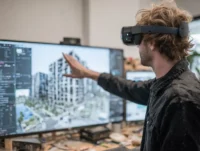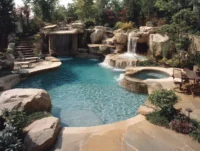Architecture has always pushed boundaries, but recent breakthroughs are nothing short of miraculous. We’re witnessing a revolution where innovation meets sustainability, transforming our built environment in ways we never thought possible. From smart materials that adapt to their surroundings to designs that integrate nature seamlessly, these advancements are reshaping how we think about spaces.
As we explore the latest trends and technologies in architectural design, we’ll uncover the stories behind these remarkable breakthroughs. Each development not only enhances functionality but also inspires creativity, challenging us to envision a future where architecture harmonizes with the world around us. Join us as we delve into this exciting journey and discover the miracles that are redefining architecture today.

The Miracle In Architecture Design Breakthroughs
The evolving landscape of architecture reflects a strong commitment to innovation and sustainability. We observe breakthroughs in design that prioritize functionality and environmental harmony.

Smart Materials
Smart materials respond to environmental changes, enhancing energy efficiency and user comfort. Notable examples include:
- Phase Change Materials (PCMs): These materials absorb or release heat during phase transitions, regulating indoor temperatures effectively.
- Self-Healing Concrete: This innovative concrete contains healing agents that repair cracks autonomously, prolonging the life of structures.
- Responsive Facades: Facades equipped with sensors adjust to sunlight and temperature, optimizing natural light and energy use.
Biophilic Design
Biophilic design emphasizes our innate connection to nature. Integrating natural elements boosts well-being and productivity. Key aspects of biophilic design include:
- Living Walls: Vertical gardens filter air and provide aesthetic benefits.
- Natural Lighting: Designs maximizing sunlight reduce reliance on artificial lighting and enhance mood.
- Outdoor Spaces: Incorporating terraces and gardens fosters connection to nature and promotes relaxation.
Modular and Prefabricated Construction
Modular construction techniques streamline building processes, reducing time and costs. Significant features include:
- Standardized Components: Off-site construction of components allows for faster assembly on-site.
- Sustainability: This method minimizes waste and uses eco-friendly materials.
- Flexibility: Modular designs enable easy adaptation and expansion of structures over time.
Digital Design Technologies
Advancements in digital technologies revolutionize architectural processes, leading to more precise and creative designs. Innovations encompass:
- Building Information Modeling (BIM): BIM allows us to visualize structures in 3D, improving collaboration and project management.
- Generative Design: This computer-aided design technique explores numerous design alternatives, optimizing for material use and aesthetics.
- Virtual Reality (VR): VR enables immersive visualization, helping clients experience spaces before construction begins.
Sustainable Practices
Sustainable building practices reduce environmental impact while promoting energy efficiency. Essential elements include:
- Green Roofs: These roofs improve insulation, reduce stormwater runoff, and promote biodiversity.
- Solar Energy Integration: Photovoltaic panels harness solar energy, contributing to self-sufficient buildings.
- Water Conservation Systems: Efficient plumbing fixtures and rainwater harvesting systems decrease water usage.
We continue to witness a miracle in architecture as these breakthroughs redefine how we design and interact with our built environments.
Historical Context
Architectural breakthroughs emerge from a rich history of innovation and creativity. Understanding this context helps us appreciate the remarkable transformations in contemporary architecture.

Early Innovations
Early innovations set the foundation for modern architecture. The invention of reinforced concrete in the 19th century enabled structures to achieve unprecedented heights and spans. The introduction of the elevator, also in the 1800s, allowed buildings to grow taller without requiring massive staircases. Additionally, the use of steel frames in the late 19th century led to the birth of the skyscraper, fundamentally changing urban landscapes. Each of these advancements marked significant milestones in architectural design, paving the way for today’s breakthroughs.
Influential Movements
Influential movements shaped architectural design throughout history. The Bauhaus movement emphasized functionality and simplicity, merging art with industry. The International Style, emerging in the early 20th century, prioritized minimalism and rejected ornamentation, focusing instead on structural elements. Modernism further pushed boundaries, advocating for open spaces and integration with nature. Postmodernism introduced diverse styles and historical references, embracing complexity in design. Each of these movements contributed to the developments we see today, inspiring a new generation of architects to explore innovative and sustainable solutions.
Notable Design Breakthroughs
Recent advancements in architecture demonstrate how innovation and sustainability can harmoniously coexist. Notable breakthroughs include sustainable architecture and smart building technologies that redefine how we interact with our environments.

Sustainable Architecture
Sustainable architecture focuses on eco-friendly practices that reduce environmental impact. Green roofs, for instance, promote biodiversity while providing natural insulation. Solar energy integration enhances energy efficiency, enabling buildings to generate power. Water conservation systems, including rainwater harvesting and greywater recycling, optimize resource use. Additionally, biophilic design elements, like living walls and natural lighting, create healthier environments, improving occupants’ well-being. These features not only enhance aesthetic appeal but also contribute to long-term sustainability goals.
Smart Buildings
Smart buildings utilize advanced technologies to improve efficiency and enhance user experience. Building Information Modeling (BIM) allows for precise planning and resource management. Automated systems, including smart lighting and HVAC, adjust to occupancy patterns, cutting energy costs. Responsive facades adapt to environmental conditions, optimizing natural light and ventilation. Furthermore, integrated sensors monitor building performance, enabling proactive maintenance and increased longevity. As we embrace these innovations, smart buildings transform urban landscapes into intelligent, adaptive environments that prioritize comfort and sustainability.
Impact On Urban Development
Architectural breakthroughs greatly influence urban development, reshaping environments and enhancing community dynamics. These advancements promote sustainability, efficiency, and aesthetics, driving the design of modern cities.

Community Engagement
Community engagement fosters a sense of ownership and connection within urban development projects. Architects design spaces that reflect community needs and preferences. For instance, inclusive public areas, such as parks and plazas, encourage social interaction and community activities. Active participation in design processes allows residents to voice their opinions and affects decision-making. Successful projects often incorporate feedback mechanisms, ensuring designs align with community aspirations.
Enhancing Aesthetics
Aesthetics play a crucial role in urban architecture, as visually appealing structures contribute to a city’s identity. Innovative design techniques employ materials like glass, steel, and natural elements to create striking facades that attract attention. Integrating art installations and landscaping into architectural designs enhances visual appeal and promotes cultural expression. Sustainable features, such as green roofs and vertical gardens, add beauty while improving environmental functionality. Engaging aesthetics not only elevate a city’s image but also draw residents and tourists, boosting local economies.
Future Trends In Architecture
We’re witnessing transformative trends in architecture that enhance our built environments. Technology integration and biophilic design lead the way in shaping these innovations.

Technology Integration
Technology integration revolutionizes architectural design and construction. Advanced computational tools streamline processes and improve project outcomes. Building Information Modeling (BIM) allows for real-time collaboration, reducing errors and enhancing coordination among teams. Drones and 3D printing facilitate site analysis and construction, making projects more efficient.
Smart technologies, such as Internet of Things (IoT) devices, enable buildings to communicate with occupants. Automated systems adjust lighting, heating, and security based on user preferences and occupancy. This enhances energy efficiency and safety while enriching overall user experiences. As these technologies advance, we see a shift towards fully integrated smart buildings, creating adaptive environments that respond to our needs.
Biophilic Design
Biophilic design connects architecture with the natural environment, enhancing human well-being. Incorporating natural light, greenery, and organic materials fosters a sense of tranquility and promotes productivity. Living walls, for instance, bring nature into urban settings, improving air quality and aesthetics.
Design elements like water features and indoor gardens further immerse us in nature. Research shows biophilic design reduces stress and enhances creativity, which benefits both residential and commercial spaces. As awareness of well-being grows, biophilic principles become vital in our architectural practices, leading to healthier, more sustainable environments.
Conclusion
The advancements in architectural design reflect a profound shift towards innovation and sustainability, enhancing both functionality and environmental wellness. We’ve seen the transformative power of smart materials like Phase Change Materials and self-healing concrete, which significantly improve energy efficiency and user comfort. Biophilic design fosters a connection to nature, incorporating elements such as living walls and natural lighting that boost well-being and productivity.
We also recognize the efficiency of modular and prefabricated construction techniques, which streamline processes while reducing costs and waste. Digital design technologies, including Building Information Modeling (BIM) and generative design, foster collaboration and revolutionize how we approach architectural projects.
Sustainability remains a core focus, with practices like green roofs and solar energy integration leading to reduced environmental impact. Our commitment to eco-friendly architecture enhances aesthetic appeal while supporting long-term sustainability goals.
Historical insights highlight the evolution of architectural breakthroughs, from reinforced concrete to the advent of steel frames that facilitated the rise of skyscrapers. Influential movements such as Bauhaus and Modernism shape contemporary trends, enriching our understanding of design.
The emergence of smart buildings represents a significant leap forward, utilizing technology to improve efficiency and enhance user experience. Integrated sensors and responsive facades transform urban environments into intelligent, adaptive spaces.
Architectural breakthroughs profoundly impact urban development. Emphasizing community engagement in design ensures spaces reflect local needs, fostering a sense of ownership and connection. Aesthetic considerations enhance a city’s identity, attracting both residents and visitors.
Looking towards the future, we embrace trends that emphasize technology integration and biophilic design. The adoption of advanced tools like drones and 3D printing streamlines processes and enhances project outcomes. An increasing focus on health and sustainability shapes our architectural practices, leading to environments that promote wellness and adaptability. Through these innovative approaches, we redefine architecture, inviting exploration of the transformative changes in our built environments.
- architectural sustainability experts
- architecture design breakthroughs
- architecture for the future
- breakthroughs in architectural design
- cutting-edge architectural solutions
- eco-friendly design advancements
- environmentally friendly architecture
- future of sustainable architecture
- future-forward building designs
- green building design trends
- innovative architectural design
- Innovative sustainable architecture
- modern sustainable buildings
- new trends in architecture
- sustainability in architecture
- sustainable architecture firms
- sustainable architecture innovations
- sustainable design pioneers
- sustainable urban planning
















Leave a comment